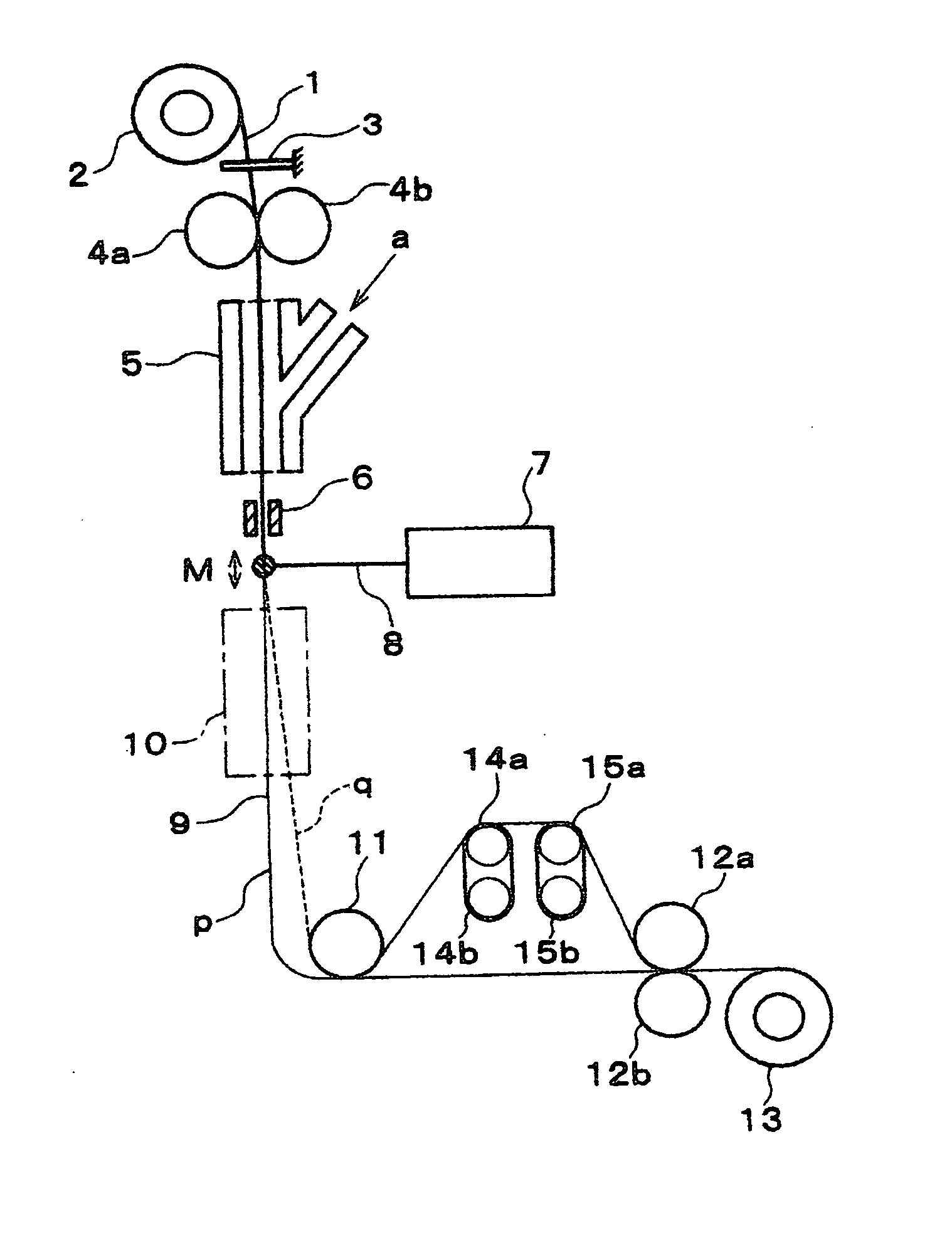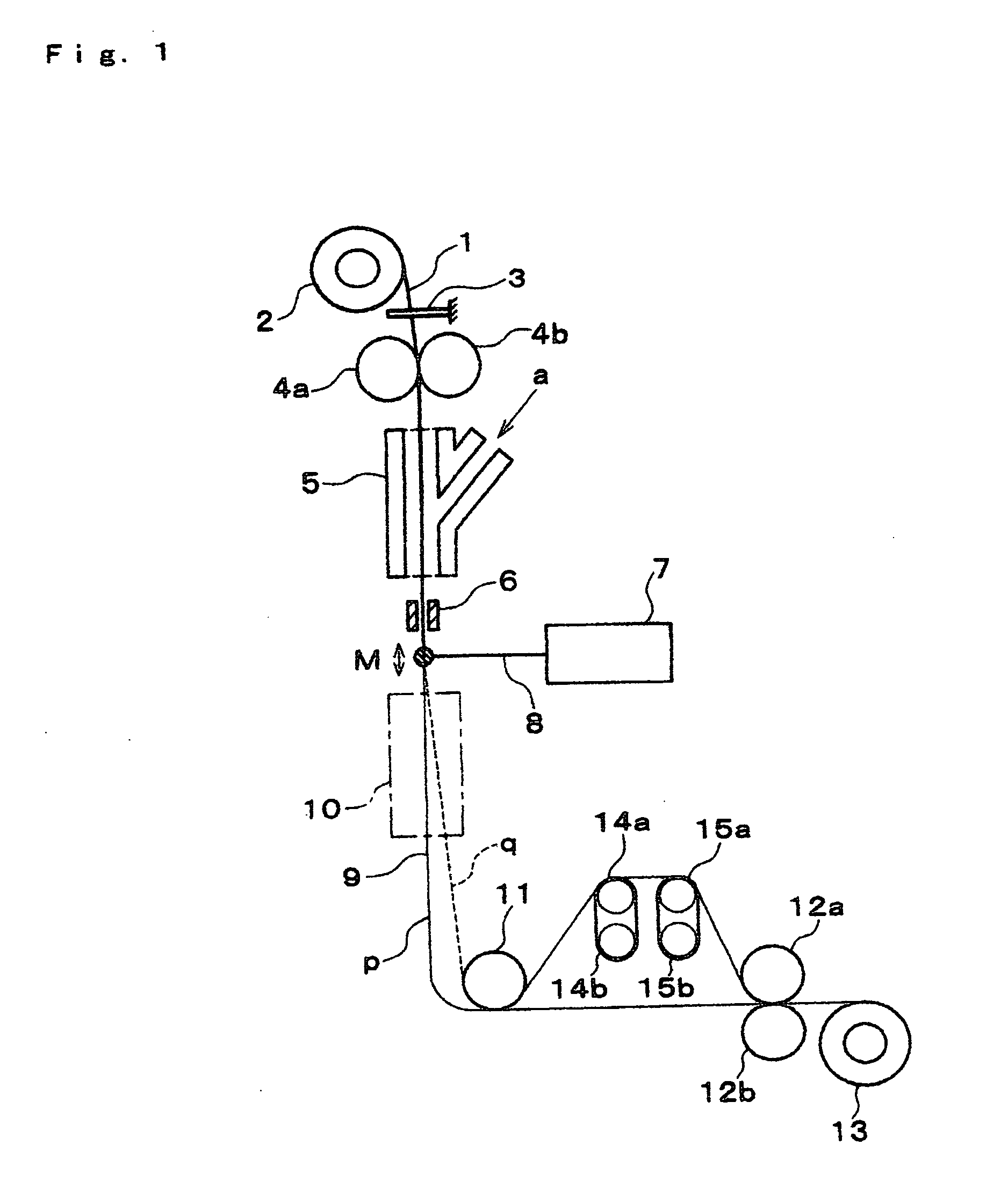Highly oriented super microfilaments
a super microfilament, high-oriented technology, applied in the direction of manufacturing tools, electric/magnetic/electromagnetic heating, melting methods, etc., can solve the problems of inability to draw simply and conveniently, high cost, etc., to achieve easy electrostatic treatment, high heat resistance, and high quality application use
- Summary
- Abstract
- Description
- Claims
- Application Information
AI Technical Summary
Benefits of technology
Problems solved by technology
Method used
Image
Examples
example 1
[0036] Undrawn nylon 6 filaments (diameter 185 μm, birefringence of 6.25×10−3, degree of crystallinity of 27.6% (based on density by floatation technique) were used as original filaments and drawn by the apparatus shown in FIG. 1. The filaments were drawn at a supplying speed of 0.47 m / min and a wind-up speed of 1414 m / min. In this case, a carbon dioxide gas laser emitter manufactured by Onizuka Glass Co., Ltd. with a maximum power of 10 W was used for the laser emitter. The laser power density was 23.7 W / cm2 and the beam diameter was 4.0 mm. The drawn filaments ran along the trace p in FIG. 1 and the distance from the laser-heating portion M to the lowermost position was 150 cm. The obtained drawn filament had a diameter of 3.16 μm (draw ratio: 3427) and a birefringence of 44.12×10−3. Comparison between the original filament and the drawn filament is shown by a scanning electron microscopic (SEM) photograph of FIG. 4. FIGS. 5 and 6 show a relation between the diameter and the biref...
example 2
[0037] Undrawn polyethylene terephthalate filaments (diameter of 240 μm, birefringence of 0.5×10−3, amorphous and isotropic state were confirmed by wide angle X-ray diffraction photography) were used and drawn by the apparatus shown in FIG. 1. The laser emitter is identical with that in Example 1. The filaments were drawn at a supplying speed of 0.30 m / min and a wind-up speed of 1400 m / min. In this case, the laser power density was 1.91 W / cm2 and the beam diameter was 4.0 mm. The drawn filaments ran along the trace q in FIG. 1 and the drawing tension at that time was 0.45 MPa when estimated from the batchwise system in the prior application. The obtained drawn filament had a diameter of 3 μm (draw ratio: 6400) and a birefringence of 38.0×10−3. Table of FIG. 7 shows a relation between diameters, a birefringence and a laser power density in a case of changing the supplying speed and the take-up speed variously for the original filaments.
example 3
[0038] Undrawn isotactic (it) polypropylene filaments (diameter of 211.0 μm, a birefringence of 0.3×10−3 and a degree of crystallinity of 47%) were used as original filaments and drawn by the apparatus shown in FIG. 1. The original filaments were obtained by melt spinning from pellets of Ace Polymer Co., Ltd. (Mw=3×105, Mw=5×104) The laser emitter is identical with that in Example 1. The filaments were drawn at a supplying speed of 0.38 m / min and at a wind-up speed of 1386.9 m / min. The drawn filaments ran along a trace q in FIG. 1 and the drawing tension in this case was 0.33 MPa as estimated from the batchwise system in the prior application. The obtained drawn filament had a diameter of 3.8 μm (draw ratio: 3082), and a birefringence of the filament was 25.6×10−3. For the original filaments, FIG. 8 shows a relation between the diameter and the birefringence in a case of changing the supplying speed and the wind-up speed variously.
PUM
| Property | Measurement | Unit |
|---|---|---|
| Length | aaaaa | aaaaa |
| Length | aaaaa | aaaaa |
| Fraction | aaaaa | aaaaa |
Abstract
Description
Claims
Application Information
 Login to View More
Login to View More - R&D
- Intellectual Property
- Life Sciences
- Materials
- Tech Scout
- Unparalleled Data Quality
- Higher Quality Content
- 60% Fewer Hallucinations
Browse by: Latest US Patents, China's latest patents, Technical Efficacy Thesaurus, Application Domain, Technology Topic, Popular Technical Reports.
© 2025 PatSnap. All rights reserved.Legal|Privacy policy|Modern Slavery Act Transparency Statement|Sitemap|About US| Contact US: help@patsnap.com



